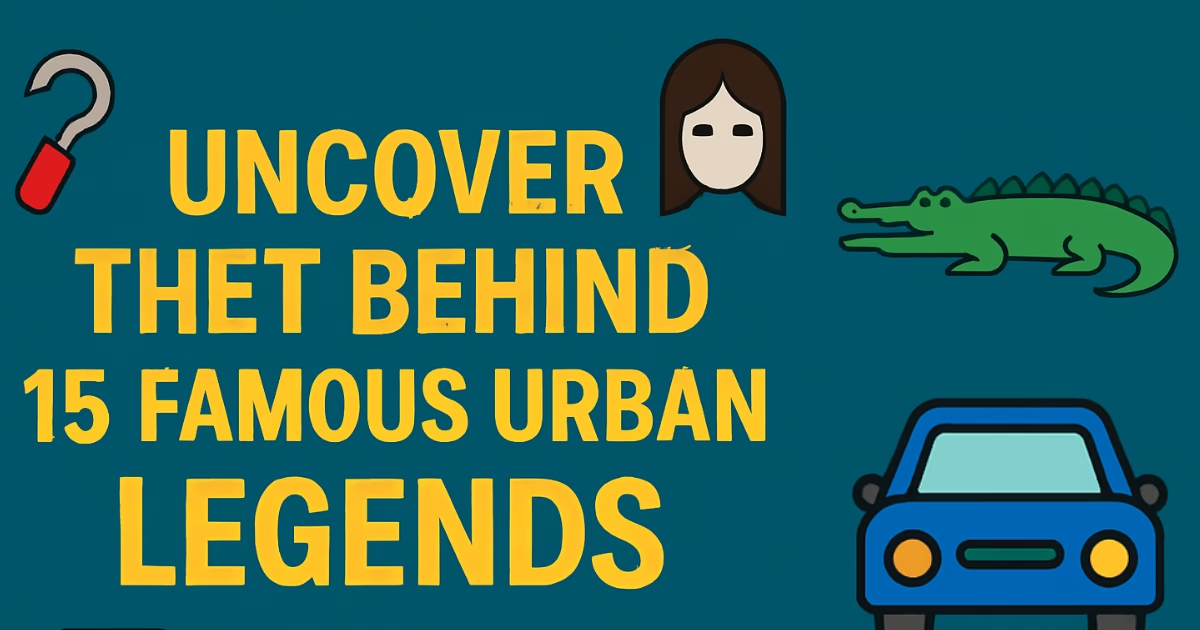Urban legends have been whispered for generations—tales that blur the line between truth and fiction. These modern myths travel fast, passed down through word of mouth, forwarded emails, and now, viral social media posts. They often sound believable, sometimes terrifying, and they tend to stick in our minds long after we’ve heard them. But not all legends are the same. Some stories have earned a special place in pop culture, becoming widely known across the world. These are what we call famous urban legends. They’re not just campfire tales—they’ve shaped fears, inspired movies, and even influenced real-life events. In this article, readers will explore some of the most well-known urban legends, their origins, and why they continue to haunt our imagination. Get ready for a deep dive into the strange and mysterious world of famous urban legends.
What Are Famous Urban Legends and Why Do They Spread?
Urban legends are modern folklore—stories told as if they’re true, but usually filled with exaggeration, mystery, or fear. What makes them powerful is how believable they often sound. They might start with a friend-of-a-friend, or be tied to a local town, making them feel personal and urgent.
Famous urban legends rise above the rest. These are the ones that go viral, cross borders, and get retold again and again. But why do they spread so fast? For one, they tap into common fears—being followed, being alone, being lied to. They also evolve easily. A tale told in the ’60s might get a tech twist in the 2020s, making it feel new again.
Media plays a huge role too. Movies, news stories, and the internet can turn a small-town rumor into a global phenomenon. And once that happens, the legend lives on.
Chilling Famous Urban Legends from the United States
The U.S. has no shortage of creepy tales that have frightened people for decades. Some of these famous urban legends have even been told so often, people believe they really happened.
The Hookman
This story became popular in the 1950s. A couple is parked in a car, alone at night. They hear on the radio that a killer with a hook for a hand escaped a nearby prison. The girl gets scared and asks the boy to take her home. When they return, they find a bloody hook hanging from the car door. The idea that danger could be just outside your window is what makes this legend stick.
The Killer in the Backseat
In this tale, a woman drives home late at night. A truck follows her closely, flashing its lights and tailgating. She panics, thinking the driver wants to hurt her. When she arrives home, she finds out the truck driver was trying to warn her—there was a man hiding in her backseat the whole time. It’s scary because it makes people think twice about safety.
The Vanishing Hitchhiker
One of the oldest American legends. A driver picks up a quiet hitchhiker who gives an address. But when they arrive, the hitchhiker is gone. The driver visits the address, only to learn the person died years ago. This one sticks because it makes people question what’s real and what’s not.
Alligators in the Sewers of New York
It sounds silly, but many believe this legend. The story says people brought baby alligators from Florida as pets, then flushed them when they got too big. These gators then grew in the sewers of New York City. Even though there’s no proof, this tale shows how fear and imagination can take over facts.
These famous urban legends continue to be retold because they play on everyday fears. They make the ordinary world feel unsafe.
Terrifying Urban Legends from Around the World
Urban legends aren’t just an American thing. Every country has its own creepy stories. Some are even scarier because they’re tied to deep cultural beliefs.
Kuchisake-onna – The Slit-Mouthed Woman (Japan)
This legend tells of a woman with a surgical mask who asks people if they think she’s pretty. If they say no, she kills them. If they say yes, she removes her mask to reveal a slit mouth and asks again. Either way, they’re in trouble. Kids in Japan used to be terrified of walking home alone because of this story.
La Llorona – The Weeping Woman (Latin America)
This ghostly figure is said to be a woman who drowned her children and now wanders near rivers, crying for them. She might mistake children for her own and take them. Many parents use this tale to scare kids into staying home. It’s become one of the most famous urban legends in Latin culture.
The Choking Doberman (Australia)
In this legend, a woman returns home to find her dog choking. At the vet, they discover fingers stuck in its throat. Later, police find a man hiding in her home—his fingers bitten off. This story went global, showing how fast fear can spread when it’s rooted in surprise and danger.
Each culture’s legends say something about what people fear most—ghosts, murderers, betrayal. That’s what keeps these stories alive.
Modern Famous Urban Legends Born on the Internet
The internet has created a new breed of famous urban legends. Some started as fiction but became so widely believed, people forgot they were made up.
Slender Man
Slender Man started as an internet image in 2009. He’s tall, faceless, and wears a black suit. The story says he stalks children and lives in the woods. Though he was created for a forum contest, many believed he was real. Sadly, this legend turned deadly when two girls tried to kill a friend to “please” Slender Man.
The Russian Sleep Experiment
This tale claims Soviet scientists locked people in a room with gas that kept them awake for days. What happens next is terrifying—people go insane, tear off skin, and lose their minds. It’s fake, but the story spread because it was written like a real report. Many readers were fooled.
The Backrooms
This is a newer legend. It says if you “glitch out” of reality, you end up in the Backrooms—a place with yellow walls, buzzing lights, and endless halls. It started as a photo posted online but grew into games, stories, and videos. People even claim to dream about it.
These legends show how digital storytelling has changed the game. A single post can become a global myth overnight.
Are Famous Urban Legends Based on Real Events?
Some famous urban legends do have real roots. But over time, the truth gets twisted.
Take the story of poisoned Halloween candy. Every year, parents warn kids not to eat treats from strangers. But actual cases of strangers harming kids through candy are almost non-existent. Still, the legend keeps people afraid.
Or the Vanishing Hitchhiker. Versions of this tale go back over a hundred years. Some think it’s based on actual accidents or ghost stories passed down. But no solid proof exists.
Why do people believe? Because fear spreads faster than facts. When a story sounds possible, our brains fill in the blanks. It’s easier to accept a scary tale than dig for truth.
In the end, most legends are fiction. But they feel real because they speak to our deepest worries—being watched, being alone, or being fooled.
The Impact of Famous Urban Legends on Society
These stories might seem harmless, but famous urban legends can shape how people think and act.
They influence movies, shows, and books. Horror films like Candyman, The Ring, and even Urban Legend are based on myths. Viewers love the mix of mystery and fear.
Sometimes, the effect is serious. The Slender Man case showed how a made-up story could push people to violence. That’s rare, but it shows the power of belief.
Urban legends also reflect the times. In older days, stories focused on strangers or dark roads. Today, they include the internet, tech, and social media. They grow with us.
And they’re not going away. As long as people share stories—whether face-to-face or online—legends will live on. They’re part of our culture, always changing, always spreading.
Also Read: 50 Fun & Valuable Things to Collect as a Unique Hobby
Final Thoughts on Famous Urban Legends
Urban legends are more than just spooky stories. They connect people, teach lessons, and reflect shared fears. The most famous urban legends have stood the test of time because they tap into things we all feel—fear, curiosity, doubt.
Whether told around a campfire or shared in a Reddit thread, these tales remind us how powerful a simple story can be. And even if we know they aren’t real, a part of us still wonders—what if?
So the next time you hear footsteps when you’re alone, or a voice in the dark, think twice. Maybe it’s just your mind… or maybe it’s the start of a new legend.
FAQs About Famous Urban Legends
1. What are famous urban legends?
Famous urban legends are widely shared stories that often sound believable but usually aren’t true. They’re passed from person to person and often reflect social fears or moral lessons. Over time, these tales become part of pop culture, even if they never really happened.
2. Are any famous urban legends based on real events?
Some urban legends may have started with a grain of truth, like a strange accident or news story. But most of the time, the details get twisted or exaggerated, turning them into something far from fact. That’s part of what makes them so fascinating.
3. Why do people believe in famous urban legends?
People believe in these stories because they often tap into common fears—being alone, being watched, or facing the unknown. When a tale feels possible, even if it’s not, it’s easy to accept it without proof.
4. Do famous urban legends exist in every culture?
Yes, every culture has its own set of famous urban legends. From the Slit-Mouthed Woman in Japan to La Llorona in Latin America, these stories cross borders and languages, showing that fear and imagination are truly universal.
5. How do famous urban legends spread in today’s world?
In the past, people shared them through word of mouth or books. Now, the internet spreads urban legends faster than ever. A post, video, or meme can turn a made-up tale into something millions believe overnight.

Hi, I’m Shafy Ali – a curious mind and passionate writer at Celiac Magazine. I cover a little bit of everything, from everyday tips and how-tos to deeper dives into topics that spark conversation. I enjoy turning research into readable, relatable content that informs and inspires. Whatever the subject, I aim to keep it clear, engaging, and genuinely useful.

